GOLDMINE
MOUNTAIN
CELLARS WINE BLOG
2012 | ||
December 4
- Where does the time go? I've been so busy with my vineyard project
near Willcox that this blog and many other tasks have fallen to the
wayside. This time of the year though there really isn't much going on,
at least not in an established vineyard. If you have vines in a low
desert environment, this is a good time to cut back on irrigation. With
the vines going dormant they really don't need much water, and if you
do have any stragglers (vines not yet going dormant), the lack of water
will help push them into dormancy. Very soon I'll start providing updates for my vineyard project near Willcox on a new website, chiricahuaranchvineyards.com. But in a nutshell here's what I've been up to:
October 8 - Sorry for the lack of updates. I've been quite busy lately sorting out various issues with my property near Willcox. As part of my evaluation of the site for a commercial grape vineyard I've done two things; 1) I planted four potted vines to serve as a "canary in the coal mine." That is, I'll watch these vines over the winter and spring to see how they hold up to the weather. 2) I placed temperature sensors in my vineyard and at Zarpara down in the established grape growing area. I'll log temperatures over the winter and spring. Based on the performance of the vines and the temperature data I'll make a go/no-go decision sometime in the spring. In order to guarantee that I would have vines available to plant should I decide to move ahead with this project, I decided to place an order for a thousand vines. These include two hundred and fifty each of Marsanne Rousanne, Mourvedre, and Vermentino. September 17 - I have some catching up to do. First, I've purchased 40 acres near Willcox, Arizona, not too far from the established vineyards in the area. 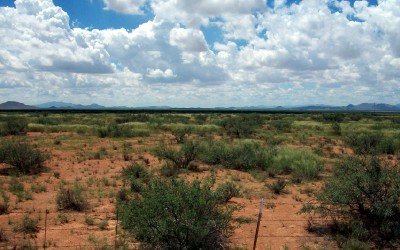 I'll be evaluating the property for wine grape production over the winter and spring. The soil and water tests have been completed and there are no problems with either, but there are still questions about the temperature. As you may know, late spring frosts are a big issue for the established vineyards on the Willcox bench. This property is 3.6 miles away from the nearest vineyards, and about 200 ft higher in elevation. These late spring frosts may prove to be more of a problem at this location, and if so, I won't be planting any vines. Instead I'll put the property back on the market and try to get something started elsewhere. If this works out I'll just be growing grapes and selling them to commercial and hobbyist wine makers for the first few years. It will take some time to get a commercial winery of my own started. Ok, next up, let's talk about making wine. As I've mentioned before I've never been 100% satisfied with the results from my own red grapes. My Pseudo Tuscan wine gets better every year, but I think there's room for improvement. Since the end of harvest season all of the freezer space I have access to has been occupied with the last of my red wine grape harvest. Last night I pulled all of the grapes out of their frozen slumber, threw them into two primary fermenters, and allowed them to thaw. The final blend was:
August 28 - Those who know me know that I don't like conducting various tests (pH, acidity, SO2, etc.) on wine. Of course, testing is necessary, and I do it when it's really important. My approach usually works just fine, but last year I lost two small oak barrels when they became "suspect". That is, I believed they had become infected with something and I actually lost one batch in the process. After that experience I decided to get more serous about SO2 testing for my barrel aged wines. Over the last year I've carefully monitored the SO2 levels in a new 6 gallon Hungarian oak barrel, and today I reviewed my notes. On average, in order to maintain 80ppm SO2, I've had to add 0.433 grams per week. Yes, nearly half a gram per week in a 6 gallon barrel. The high and low numbers were not much different than the average. I wouldn't have thought it would take so much, and that definitely explains where I went wrong last year with my other barrels. As they say, "Your mileage may vary". Your barrels may require more or less than this average SO2 addition. Make sure to test your SO2 levels on a regular basis. In these smaller barrels I suggest that you don't go any longer that a month between tests. August 12 - It's done. Harvest is complete. The last of the red grapes have been processed and frozen. These include Barbera, Nebbiolo, Petite Sirah, Grenache, and Cabernet Sauvignon. These will be combined into a single batch and cofermented. Yes, it's an odd combination of grapes, but I have such small quantities of each it doesn't make sense to ferment them separately. This will be the second batch of my Pseudo Tuscan red blend for the year, and with it, I'll be trying two techniques new for me, saignée and a partial whole cluster fermentation. I've never been completely happy with the way this red blend turns out, so I'm trying the last two things I can think of that might help give it some extra character. I may also step up the addition of tannins pre-ferment. I bottled the second of three main batches of the Bordeaux red blend (Diaspora) made last year from California grapes. This batch, Lot 3, was fermented with RC212 and you can really tell the difference. It's much more fruit forward than the other two. Lot 2 was fermented with BM4x4 and Lot 1 was fermented with Bordeaux yeast. It will be interesting seeing how these three batches develop and change over time. There were other differences as well. I tried different types of tannin produces in each pre-ferment, and the first batch (Lot 1) included Cabernet Sauvignon whereas the other two are equal parts Cabernet Franc and Merlot, and a smaller amount of Petite Verdot. Before I forget to make note of it (I don't keep good notes outside of this blog), the first batch of Pseudo Tuscan for 2012 was composed of the following:
Something unusual happened with the Barbera I harvested in Tucson on Saturday. I used the crusher-destemmer on location, added 80ppm SO2, then brought the crushed grapes home in a 20 gallon Brut and left it at room temperature. My normal routine involves treating with SO2 at crush, letting it rest for 12 hours, then treating with enzymes and letting it go another 12 hours and finally pitching the yeast. Sometimes I'll do an extended cold maceration if I can find a way to keep the must cold, but this time that wasn't practical. Mid-day Sunday I returned home from harvesting Tempranillo near Benson to find my Barbera fermenting vigorously despite not having pitched the yeast. Now some wine makers embrace these wild fermentations, but the results are not predictable. In this case I was able to detect a slight off odor coming from the primary. I would describe this odor as a varnish smell or perhaps nail polish remover. This indicates the presence of Ethyl Acetate. In small quantities this can be a good thing, but in large quantities it's a definite wine fault. In a bit of a panic I immediately inoculated the must with BM4x4, my chosen yeast, then over the course of 8 hours I inoculated three more times. Gradually over the next 24 hours the off odor diminished, but only time will tell if I've produced a great wine with extra complexity, or a lousy wine that should be distilled into grappa. Before I forget, the final blend on my Tres Blancos white wine was roughly 60% Muscat, 20% Sauvignon Blanc, and 20% Viognier. As usual, I fermented this batch with D47 at 61 degrees F. July 29 - Harvest is nearly finished. All that remains is the Nebbiolo and Cabernet Sauvignon at my Supersition location, and the Petite Sirah and Barbera at my Usery Pass vineyard. On the remaining grapes I'm seeing good color, brown seeds, and Brix numbers in the 21 to 23 range. Another week and the 2012 harvest should be behind me. I crushed and pressed my whites today. Some harvested earlier were frozen, and the rest were harvested in the last few days and kept under refrigeration. As usual, acid was low and the must was brown. Neither is a real concern. I know how to tweak the acid and the brown must will soon be a nice clear straw yellow. I user Rapidase Vino Super enzyme on my whites, and I add a small dose of Bentonite when I pitch the yeast, but I suspect the color would clear up without the enzyme or bentonite. July 20 - Harvest has been keeping me busy; so busy that I haven't been able to post any updates to this blog recently. On June 30th I left for a short vacation in Brazil. Upon my return on July 11th I had to immediately and quickly begin bringing in the first of my wine grapes. So far I've harvested all of my Sauvignon Blanc, Viognier, and Tempranillo, along with part of the Barbera. I've also finished harvested the Neptune, an odd native variety that I use in a sweet wine I make for relatives. Still waiting for their turn to be harvested are Cabernet Sauvignon, Petite Sirah, Grenache, and a few other red varieties. Although this remains a hobby project, as my micro-vineyards become more productive with age, I'm finding it difficult to keep up with them during the harvest season just working in my spare time. On another note... I have something big in the works. Something I'm anxious to share with you, but not quite yet. Stay tuned! June 29 - Harvest begins!!! Over the last few days I've brought in the first of the 2012 harvest. To date I've harvested mostly table grapes, including part of the Thompson Seedless, Concord Seedless, and Mars Seedless, along with all of the Himrod (the birds apparently took most of this variety before I got the nettting up). I also harvested a small amount of Muscat. The extreme heat has taken a toll on some of my grapes, but I'm still confident I'll be able to produce a decent batch of Tres Blancos, my white blend, along with a good amount of Pseudo Tuscan, my red blend. I'm also making arrangements to get some grapes from other sources. More on that later. June 26 - I had a discussion today with a casual acquaintance, someone I've known for a long time, and I was surprised to learn that he has had a hobby vineyard for eight years. More surprising is what I learned from him about soil preparation and amendments. He told me that during the first year he had a vineyard, the vines didn't do so well. After trying a rich compost and sand (75%/25%) blend in his regular garden and seeing incredible results, he decided to pull up his year old grape vines, re-dig the holes, then replant them with the same compost and sand blend. After that in their second year of growth his vines grew like weeds. Furthermore, the issue with uneven ripening that so many of us experience is something he doesn't see in his vineyard. This issue of uneven ripening isn't just a low desert phenomenon. In fact an experienced French wine maker I know who grows grapes and makes wine in Paso Robles has been dealing with the same issue. He has told me that it's an indication of stress, but he wasn't able to resolve it in the vineyard. He has actually made a sizable investment in equipment that will facilitate a hand sort of his entire harvest. Could compost and sand be the cure for this issue? I wish I could replant my vines to find out. . June 24 - Today I bottled the first of four Bordeaux style blends from Brehm grapes. The Diaspora name was a last minute choice on my part. It means a migration of people from their ancestral homeland, and it originates from the Greek diaspeirein which means "to scatter". This seems appropriate given the yearly exodus of grapes from California to wine makers throughout North America. This first batch was comprised of 43% Plumb Ridge Cabernet Sauvignon, 43% Carneros Merlot, and 14% Plumb Ridge Petite Verdot. It received a dose of Tan Cor Grand Cru tannin pre-ferment, and I used Bordeaux yeast. Post ferment I used the VP41 culture to take this batch through MLF. It was aged on French Oak spirals, and later it spent about three months in a mostly neutral Hungarian oak barrel. Each of the three primary batches is unique in terms of the blend, tannin protocol, and yeast selection. I'm quite happy with the way this turned out. It's good. Maybe not Opus One good, but better certainly than a majority of lesser priced commercial wines. It will be interesting to compare this batch with the others after they've all been bottled and had some time to age. June 8 - Veraison is underway at all three of my locations. 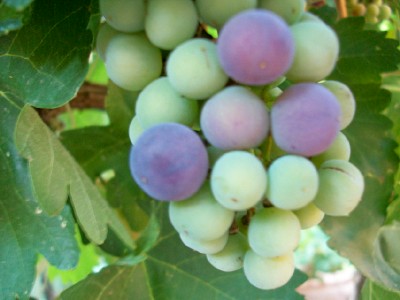 Tempranillo
Going Through Veraison First to start this transition was the Mars Seedless at my Usery Pass vineyard. That was nearly a week ago. Days later the Concord Seedless at my San Tan vineyard started to take on color, and Tempranillo at my Superstition location was next. This may be just slightly ahead of past years.
May 30 - The other day a friend asked "Why would the leaves on my grape vines start to look like paper?" I thought I knew what was wrong, but before I answered his question I asked "Have you seen a number a small black flying insects?" He said, "Yes, as a matter of fact I have." With that my suspicions were confirmed. He had Leaf Skeletonizers, and apparently a pretty serious infestation at that. I instructed him to immediately go to the nearest garden center and get a spray bottle of Sevin (Carbaryl), then go home, prune the vines back removing any leaves bearing eggs or the distinctive yellow and black larvae, wrap this pruned material tightly in plastic bags, then spray the remainder of the vines with Sevin. My voice and my directions conveyed a sense of urgency, one that he didn't immediately understand. The next day though when we spoke again he fully understood the need to act quickly. But too much time had elapsed before he sought my advice. Both of his backyard Thompson Seedless vines were devastated. He passed along the following photos to show just how bad they were. 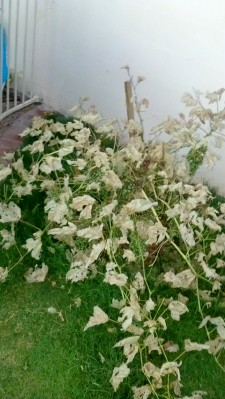 Thompson
Seedless infested with Leaf Skeletonizers 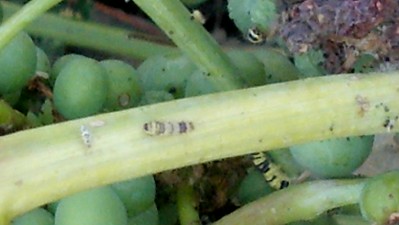 Leaf
Skeletonizer Larvae All hope was not lost. Despite being ravaged by these pests, I knew these vines could stage a comeback. I further instructed him to prune his vines back to almost nothing, and then to water them heavily every other day until they are established again. When heavily pruned and then watered like this, grape vines will respond as if it's spring again. They will go through bud break and grow vigorously for a while. Although my friend lost his meager grape harvest for this season, he should be back on track for future harvests. As an added bonus, this exercise gives him a chance to get his vines trained to proper trellises. As you may have noticed they were growing largely on the ground. When we last spoke about his vines he indicated that they were growing again, just like I said they would. May 27 - A friend recently sent me a link to this story in the San Francisco Huffington Post: Sanliang Gu, Fresno Professor, Works To Grow A Later And Tastier Grape. Basically this professor has discovered that if he prunes off all fruit in June before it ripens, the vines will set another crop which will ripen later when it's cooler. This allows him to get much better quality grapes in a hot climate. The basic concept is nothing new. Many have experimented with pruning and irrigation techniques in an effort to shift the harvest earlier or later. Results though have been mixed. It seems that Professor Gu may be on to something here. This is something we should experiment with in the lower deserts of Arizona. May 25 - I've been getting a little help at my San Tan vineyard.  Recently
at a property adjoining the location of my grape vines in Queen Creek
the family there acquired a number of chickens and they have allowed
them to roam free. They spend most of their time though in my vineyard.
Do I mind? Well, no. There are many advantages to having chickens in
the
vineyard and few disadvantages, at least few that I've found so far.
They eat a lot of insects and some weeds. The weeds they don't eat tend
to be eliminated by their constant scratching and pecking. Since this
picture was taken they have cleared most of the remaining undergrowth
and groundcover. Also, the fertilizer they leave behind should
gradually benefit the vines. One unexpected plus has been the
elimination of the gophers. I've been struggling with gophers in this
vineyard for years, but since the chickens were introduced I've seen
nothing of them. I've only found two small issues with this so far;
first, any immature vines with green leaves within reach of the
chickens have to be surrounded with chicken wire, otherwise they will
gradually strip them of their leaves. Also, the grapes on any vines not
properly trained to the middle wire will be eaten long before they
ripen. I'm not exactly breaking new ground though with having fowl in the vineyard. Chuck Blethen once told me that years ago when he had a small vineyard near Scottsdale he had peahens that were allowed to roam the vineyard. He was quite an advocate for this type of arrangement. May 15 - AZ Wine Makers did a field trip last weekend to St. Anthony's Monastery near Florence. 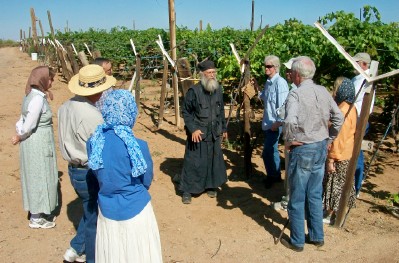 What brought us there was not the incredible art and architecture or the beautiful gardens, but instead the vineyards and wine making efforts of Father Menas. This was actually our second visit to the monastery. Father Menas is always a gracious host and a great source of information about growing wine grapes in the lower deserts. He shared with us some samples of his handiwork. All of his wines were quite impressive, but I was particularly impressed with what he's doing with Aleatico. I think more of us low desert grape growers need to plant this grape. April 24 - If you have grape vines you must have a spraying schedule. No ifs, ands, or buts. If you wait until you see a problem to start spraying then you may not get ahead of it, at least for that season. Now what you spray is up to you. I'm not convinced that a totally organic spraying program would work in an urban desert vineyard, but it may be possible. Certainly there's much you can do with organic chemicals, especially for powdery mildew. I was spraying pesticides this weekend and I saw a few adult leaf skeletonizers at my Superstition Springs location. I have yet though to see any eggs or larvae. That could be a sign that my spraying program is working. It seems like there are many angles on every story in the news. The stories related to Imidacloprid and Colony Collapse Disorder are no different. Questions have been raised about the methods and test parameters used by those conducting the recent studies which in turn spawned these news stories. At this point I can say with some certainty that if applied to a flowering plant that attracts bees Imidacloprid could devestate locate hives. Fortunately bees have no interest in grape flowers so I will continue using this incredible pesticide. I was interviewed recently for a featured amateur article for Arizona Vines and Wines. I approached that opportunity with mixed feelings. While it's a bit of an honor to be featured like that, it was a bit strange puting it all out there, so to speak, for all to read. It will be interesting to see what the article says about my lowly experiments in desert viticulture. March 25 - If you've been following this blog for any length of time you're familiar with my fondness for Imidacloprid, an extremely effective yet surprisingly benign systemic pesticide. Yet I would be the first to admit that if misapplied this pesticide has the potential to be severely detrimental to beneficial insects like honeybees. In fact, Imidacloprid is frequently blamed for Colony Collapse Disorder. What has puzzled me though is how this chemical would find its way into a bee hive. You see, Imidacloprid is widely used on corn crops all over the U.S., but bees have no interest in corn. Like grapes, corn doesn't produce flowers that would interest bees, so corn couldn't be a source of tainted nectar or pollen for them to bring back to their hive. In a recent study the solution to this mystery was revealed. It seems that bee keepers are to blame. They feed their bee colonies corn syrup at various times during the year, and the corn syrup is tainted with a small amount of Imidacloprid. Where does this leave us? Well, the obvious solution would be for bee keepers to feed their colonies something else... perhaps corn syrup certified to be free of Imidacloprid. But of course the obvious solution isn't always the one chosen. Politics will almost certainly come into play in this debate, which could be that Imidacloprid is simply banned altogether. That's what happened in Europe. Now I'm sure I could get along without this pesticide, but I'm not immediately sure how. For several years I battled grape leafhoppers at my Superstition vineyard. I was only able to eliminate them after applying Imidacloprid to the soil as a systemic in conjunction with Carbaryl applied to the canopy. Having run out of Imidacloprid this year, and with future availability uncertain, I've just purchased enough to hold me over for the next four years (four applications in all). Am I paranoid? Well, perhaps, but I'll sleep better knowing I'll be able to continue using this pesticide for a number of years to come.. Mead, The Other White Wine Some believe that mead is the oldest type of fermented beverage on Earth, yet many today have no idea what it is. Mead is simply honey wine; the fermented product of honey, water, and yeast. The earliest archaeological evidence for the production of mead dates to around 7000 B.C., but since making mead doesn't require the cultivation of plants and it's so easy to inadvertently make, some believe that it was first made far earlier than that. It may have even been independently invented (or discovered) at various times around the world. In fact, mead has featured prominently in cultures as diverse as the Vedic religion of ancient India, the mythology of the Norse people, and it was the preferred drink of many of the great philosophers of ancient Greece. Although interest in mead has not been as great in recent generations as it once was, in some parts of the world mead making traditions have been kept alive. Some monasteries in Europe with a tradition of bee keeping have also made mead. In various corners of northern Europe where summers are too short and cool for grapes, mead has continued to be a popular beverage. There are actually many different types of mead. First and foremost, subtle differences in honey can carry through to the finished mead. At your local grocer you are likely only to find products labeled 'honey' or 'clover honey'. Large commercial producers simply buy honey from various bee keepers, then they blend it, heat it, and push it through a filter. This processing removes anything that would have made the honey unique. They essentially strip the honey of its character. If you want to make a mead that is truly unique and expresses the terroir (that sense of soil, climate, and area) you need to find locally produced honey. Fortunately locally produced honey is fairly easy to get in Arizona, and varieties such as orange blossom, mesquite, and desert wildflower are excellent for making mead. But differences in mead recipes aren't limited to just the variety of honey. Mead may be flavored with various spices, producing a beverage called metheglin, and if grape juice or some other fruit is added pre-ferment the result would be called a pyment or melomel. Other popular types of mead include cyser (apple mead), acerglyn (maple mead), and rhodomel (rose petal mead), among others. If you want to try making mead at home you could start with a simple 'show mead' recipe, which is just honey, water, and yeast. Combined with a sweet mead yeast, three pounds of honey per gallon batch will yield a sweet or medium sweet mead and two pounds per gallon will produce a dry beverage. Another recipe that's a perennial favorite among hobbyists is Joe's Ancient Orange, the recipe for which can be found on line. A mead that is finished sweet or flavored with fruit or spices will be ready to drink much earlier and will be more palatable. Dry show meads can start out rather rough around the edges, but after being cellared for a number of years they can be transformed into a delicate beverage with subtle fruit and floral notes. This is generally attributed to complex alcohol molecules known as fusel oils. Even small amounts of these fusel oils can make a mead taste a bit like rocket fuel, but over time these molecules can react with acid and break down to form esters which enhance flavor and aroma. If you'd rather just buy someone else's handiwork, you're in luck. Several commercial wine makers in Arizona have tried their hand at making mead, and most large wine stores carry at least a few brands from Arizona or elsewhere. March 11 - Where does the time go? Most of my vines are showing some signs of life, but the Thompson Seedless and Chardonnay at my Usery Pass location are way out in front. They are growing like they are on steroids. I've completed spraying Imidacloprid at all three locations. Those of you who have been following my exploits for some time will recognize this systemic pesticide. I've been using it for several years now and as far as I'm concerned it's a gift from God. It does a fantastic job, when paired with foliar pesticides, at dealing with sap sucking insects like grape leaf hoppers. I spray it just once a year, at bud break, onto the soil around each vine and I have no trouble with leaf hoppers at all, and my issues with leaf skeletonizers are much reduced as well. February 28 - Bud break has occurred! This year the first vines to emerge from their long slumber were the few Chardonnay vines at my Usery Pass vineyard. From the looks of them I'd guess that bud break happened around February 23 or 24. Right behind them were the Thompson Seedless at my San Tan vineyard. They emerged from dormancy around February 26. February 15 - I do apologize for the lack of updates. Things have been fairly quiet in the vineyards but busy otherwise, so my attention has been elsewhere. Pruning is finally complete at all three of my locations. I still need to do one more pre-season anti-fungal spraying, and I also need to complete the application of fertilizer. I've started on my next article for Arizona Vines and Wines. This one will be on St. Anthony's Monastery near Florence, Arizona, with a special emphasis on the work of Father Menas concerning desert viticulture. February 1 - Things are starting to get busy again in the vineyards. Pruning, fertilizing, and general vineyard clean up and repairs have kept me busy. I still believe that there exists an ideal pruning and trellising strategy for the lower deserts... one unlike those commonly employed elsewhere, but for now at least, I'm switching my wine grapes over to conventional bilateral cordons. I've been experimenting will several approaches, but I'm not sure they have improved grape quality. Between now and mid-April is the time to apply fertilizer. I strongly believe that fertilizing in the summer and fall are bad ideas around here. Our summer temps are such that the new shoots and tender leaves that might grow in response to fertilization could be damaged. Also, fertilizer in the fall could delay dormancy, which is a challenge in this environment to begin with. Just before bud break (which should occur in early to mid March) I need to start my spraying program. Before bud break I'll apply a fungicide to the bare vines and Imidacloprid to the soil. My spraying schedule for 2011 was largely successful, so I'll probably repeat it for 2012. I may try, however, incorporating lady bugs this year. January 2 - Fall is my favorite day of the year in the lower deserts of Arizona. 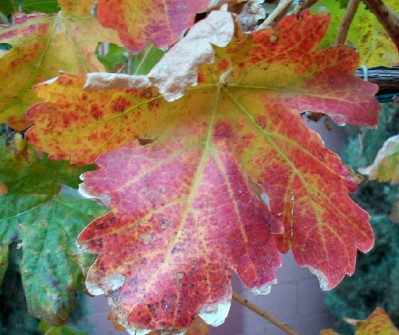 As you may note in the picture above, there are some signs of Powdery Mildew. Controlling PM has been a constant struggle for me, and this reinforces the need for winter spraying of anti-fungal agents. As I write this though, virtually all of the leaves have fallen. In fact, I have some catching up to do on this blog. In early November, along with other members of AZ Wine Makers, I ordered grapes from Brehm Vineyards in California. 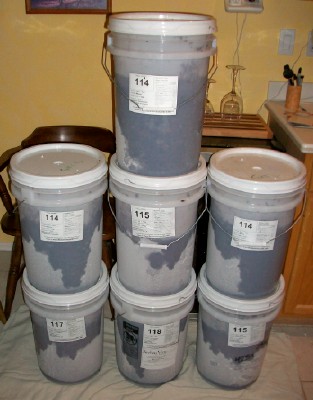 I
ordered seven buckets of four varieites, including Merlot, Cabernet
Franc, Cabernet Sauvignon, and Petite Verdot. I split this up among
three primary fermenters, each with a different yeast strain and tannin
protocol, as well as a different percentage of these four varieities.
At this time all three batches are coming along nicely and I'm not sure
whether they will remain as three seperate batches through bottling, or
be blended in some fashion. I'm presently working on my next two articles for Arizona Vines and Wines. One on blending and one one starting a backyard vineyard. I hope they turn out well. | ||
| 2011 Archive | ||
| 2010 Archive | ||
| 2009 Archive |
| Home | About Us | Wines | Vineyards | Blog |